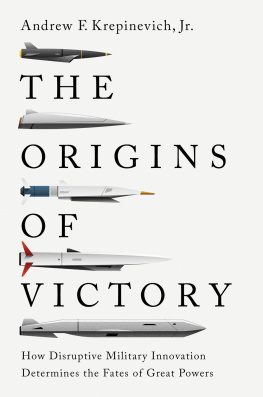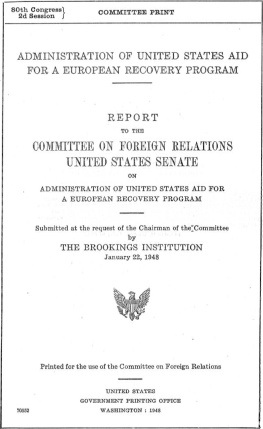THE LAST WARRIOR


Copyright 2015 by Andrew F. Krepinevich and Barry D. Watts
Foreword copyright 2015 by Robert M. Gates
Published by Basic Books,
A Member of the Perseus Books Group
All rights reserved. Printed in the United States of America. No part of this book may be reproduced in any manner whatsoever without written permission except in the case of brief quotations embodied in critical articles and reviews. For information, address Basic Books 250 West 57th Street, New York, NY 10107.
Books published by Basic Books are available at special discounts for bulk purchases in the United States by corporations, institutions, and other organizations. For more information, please contact the Special Markets Department at the Perseus Books Group, 2300 Chestnut Street, Suite 200, Philadelphia, PA 19103, or call (800) 810-4145, ext. 5000, or e-mail .
Set in 10.75 point Adobe Caslon Pro
Krepinevich, Andrew F.
The last warrior : Andrew Marshall and the shaping of modern American defense strategy / Andrew Krepinevich and Barry Watts. First edition.
pages cm.
Includes bibliographical references and index.
ISBN 978-0-465-08071-7 (e-book)
1. Marshall, Andrew W., 1921 2. United StatesMilitary policy. 3. United States. Department of Defense. Director of Net AssessmentBiography. 4. United States. Department of DefenseOfficials and employeesBiography. 5. Rand CorporationBiography. 6. Military planningUnited StatesHistory20th century. 7. Military planningUnited StatesHistory21st century. 8. United StatesForeign relations. 9. Strategy. 10. Cold War. I. Watts, Barry. II. Title. III. Title: Andrew Marshall and the shaping of modern American defense strategy.
UA23.K77622 2014
355'.033573dc23
2014024139
10 9 8 7 6 5 4 3 2 1
To
Andrew W. Marshall
and in Memory of
James R. Schlesinger
The Fathers of Net Assessment
CONTENTS
.
.
T his book chronicles the life of a remarkable, but little-known nonagenarian: Andrew Marshall, who has served every defense secretary extending back to James Schlesingers tenure during the Nixon administration. The books authors, Andrew Krepinevich and Barry Watts, are well qualified to tell Marshalls story. Both have known and worked for Marshall for some three decades; Krepinevich also served on the Defense Policy Board during my tenure as secretary of defense.
The authors describe the book as Marshalls intellectual biography. It is that, and more. It offers a unique perspective on the history of the Cold War, as well as the quarter century that has passed since the Berlin Walls fall.
In the course of their book, Krepinevich and Watts introduce us to Marshalls groundbreaking work on organizational theory, which came to have a profound influence on our understanding of the Soviet leaderships decision-making process. His influence was revealed in Roberta Wohlstetters Pearl Harbor: Warning and Decision, and Graham Allisons Essence of Decision. Both of these works greatly changed the way in which we viewed the role of intelligence, our ability to achieve early warning of an attack, and our capacity for effective deterrence. Both authors cited Marshall as the inspiration for their work.
In the late 1960s, during his second decade on the staff at the RAND Corporation, Marshall began his effort to address the limitations of systems analysis, while also looking for ways to improve the United States ability to craft better strategies in what had become a long-term competition with the Soviet Union. The result was his analytic methodology known as net assessment. It only took a few years before an Office of Net Assessment was established at the Pentagon, with Marshall as its head.
Thanks to its charter to think innovatively on matters of strategic importance, during its forty-one years existence the Office of Net Assessment (which is to say, Marshall himself) has consistently identified emerging challenges and opportunities that required the attention of the Defense Departments senior leadership. For example, in the early 1970s the CIA estimated the burden Soviet defense spending placed on the USSRs economy to be 6 or 7 percent. Marshalls independent assessment of the Soviet defense burden led the CIA to double its estimate. This led to a fundamental rethinking of our long-term competitive position in the Cold War. It convinced a number of key senior leaders that it would be difficult for the Soviets to sustain this level of effort over the long term. Put another way, it suggested that time was on our side. A decade later, Marshall was proved right.
Later, Marshalls development of competitive or cost-imposing strategies as a way of imposing disproportionate costs on Americas enemies helped offset declining defense budgets toward the latter half of the 1980s. The concept was simple, yet profound. Instead of constantly looking for ways to respond to Soviet threats, Marshall argued, we should also look for opportunities to undermine the value of their military investments. Beginning in the late 1970s, in looking at the Soviet militarys heavy investment in submarines, Marshall suggested we exploit our advantages in quieting technology and in undersea sensors to enable our submarines to avoid detection while also enhancing our ability to detect Soviet subs. In the wake of the Carter administrations cancelling of the B-1 bomber, Marshall strongly urged then defense secretary Harold Brown to stay in the bomber business even though the Soviets had no effective defense against our nuclear missile forces. Marshall pointed out that, while this was true, we needed to look at the bigger picture. The USSR, he noted, had the worlds longest border. As the Berlin Wall and the shooting down of a Korean airliner that wandered into its airspace showed, its regime was determined to control access to its territory. To this end they had deployed a massive air defense system, primarily to defend against the U.S. bomber force. By maintaining that force, Marshall noted, we would incentivize the Soviets to maintain and modernize their advanced air defense system, which cost far more than our B-2 stealth bomber program. By the mid-1980s defense secretary Caspar Weinberger was making competitive strategies like these a centerpiece of his defense strategy.
As the Cold War approached its end, Marshall was already exploring the strategic horizon a decade or two out. As we were negotiating the INF Treaty with the Soviets in 1987, Marshall was informing senior Pentagon officials that the biggest challenge the United States would face in the coming decades was the rise of China to great power status, eclipsing the Soviet Union. The greatest potential opportunity would come, he declared, from the onset of precision warfare, what became known in the 1990s as the Revolution in Military Affairs. He thereby identified the emerging revolution in precision-strike warfare that has reshaped major components of our military.
More recently, during my tenure as defense secretary, Marshalls Office of Net Assessment brought to the fore the emerging challenge to U.S. power-projection from rivals developing what is now commonly referred to as anti-access/area-denial capabilities. He also demonstrated the need for our military to adopt new concepts of operation, such as Air-Sea Battle, to meet the challenge.
Next page










